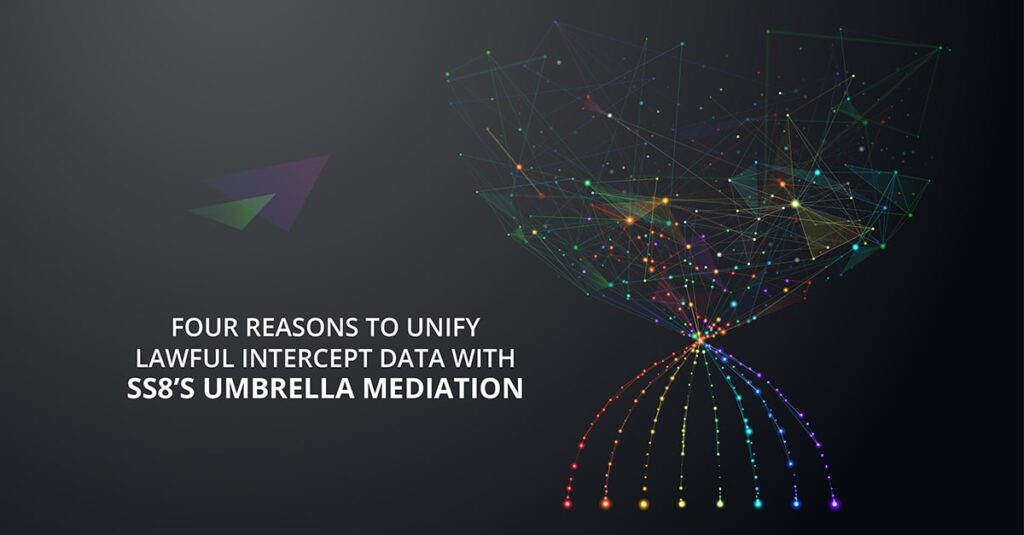Most telecommunications carriers operate equipment from different generations of technology, and often have multiple vendor environment. Carriers can accrete these layers over time, as their networks transition from 2G to 3G to 4G and now to 5G. This same accumulation is seen as carriers graft another company’s network onto their own as part of a corporate acquisition. These processes lead to many different mediation functions (and versions) in use for lawful interception that are not cross-compatible among equipment from different vendors. Making matters more complex, handover standards evolve over time, so that older telecom equipment or monitoring and analytics software only conform to older standards versions.
From the communication service provider (CSP) point of view, this lack of standardization across network equipment and services can add complexity or even interfere with a smooth response to lawful intercept orders. For law enforcement agencies (LEAs), the complexity created by disparate handover formats—made much worse when multiple carriers are involved in an investigation—creates inefficiencies and limits usability. Umbrella mediation abstracts away this complexity, making it possible for both CSPs and LEAs to treat intercepted data from all sources as a single coherent whole, without regard to specific mediation functions.
Reason #1: Simplify CSP Operations
The Operations teams at CSPs must routinely respond to court orders for lawful interception of specific data by making the required configuration changes to network equipment. Where multiple flavors of mediation functions exist, these operators must maintain the unique tool skillsets and configuration requirements for each one, adding complexity for staff as well as training requirements for the CSP. In addition, the variability can increase the incidence of human error and the complexity of troubleshooting. Providers that attempt to unify the mediation environment by building in-house tools typically find that effort to be cumbersome and cost-inefficient.
Umbrella mediation capabilities built into SS8 Xcipio provide single-pane-of-glass access to all mediation functions, and operators need not be concerned with the specifics of the underlying equipment. This approach dramatically reduces complexity for the operator and eliminates the need to maintain multiple skill sets to configure diverse mediation functions. CSPs avoid the associated added training requirements, also relying on SS8 expertise rather than taking on a custom unification development project.
Reason #2: Segregate and Prioritize Intercepted Data
When lawful intercept data is handed over to an LEA, a control structure must be in place to restrict access to authorized parties only. This is particularly the case when mediation functions send overlapping sets of lawful intercept data to multiple agencies or multiple groups within a given agency. Likewise, different levels of criticality must be observed among various lawful intelligence operations, such as an imminent public threat versus background information for a long-running investigation.
Xcipio offers hierarchical access control to segregate intercepted data by limiting access to a specific agency, individual divisions within an agency, or to specific individual users. In addition, dedicated bandwidth and compute can be allocated for tasks such as transcoding between codecs to guarantee availability for high-priority investigations. Therefore, for example, investigating a drug trafficking will not interfere with preventing a bomb attack.
Reason #3: Support Any Codec Requirement
Audio coding for voice on equipment from various vendors may use a range of codecs, some of which may not be compatible with the equipment in use by the relevant LEA. Often, an LEA’s equipment is limited to support basic codec versions, and it may not support different decoding rates for the spectrum of sound, for example. Because of budgetary limitations, an LEA might license only a narrowband codec, pushing down the quality of audio received as full band to the point where it could be unusable. Making the situation more complicated, multiple LEAs may be involved, some of which may have specialized requirements.
The Xcipio umbrella mediation function closes this gap, meeting LEA audio requirements so they can make full use of the intercepted data handed over to them. CSPs can use Xcipio to transcode audio, either to use basic codecs that are generally available or for compatibility with an LEA’s specific system requirements, prior to handover. Either of those approaches (or a combination) can accommodate simultaneous complex lawful intercept requirements from multiple LEAs.
Reason #4: Address Handover Data Formatting Inconsistencies
Formatting can be inconsistent across different network services, even when they use the same formatting standard, because of how different vendors interpret requirements and enact the optional and conditional aspects of the standard. In many cases, mismatches in data encoding interfere with lawful intelligence operations unless that data is scrubbed and normalized. Many LEAs also have specific formatting requirements for handover data, and because a given CSP must typically support many agencies and jurisdictions, the data-preparation requirements can be complex and require significant resources to support.
By placing a data-normalization layer between the CSP and the LEA, Xcipio removes the complexity associated with handling data formatting issues. Ingesting raw data from the CSP, Xcipio handles issues—even within the same standard—such as schema mismatches, missing fields, and data alignment before exporting the data according to the requirements of various LEAs. This data-formatting conversion is distinct from transcoding, although both may be performed together. By transparently making whatever adjustments are needed to the formatting of lawful intercept data, Xcipio improves the flow and interoperation between CSPs and LEAs, with lower complexity and less effort.
Conclusion
The umbrella mediation functionality of Xcipio streamlines data management and transformation tasks for data handover from CSPs to LEAs that might otherwise interfere with lawful intelligence operations. Using Xcipio for umbrella mediation also eliminates skill gaps and time-consuming tasks for Operations teams at CSPs. In particular, retiring custom-built in-house tools and manual processes saves on resources, as well as providing a single-source solution for all transcoding and data-normalization tasks. Xcipio also offers a structure and tools for defining the access and priority of intercepted data, as well as the ability to transcode and format the data as needed for each LEA recipient.
Click here to learn about SS8’s full mediation solution for CSPs.
About Dr. Keith Bhatia

As CEO of SS8, Keith combines his broad technical and market knowledge to advance the future of lawful intelligence. In his tenure, he has positioned SS8 as a leader in a world connected by 5G and shaped by increasing digitalization and automation. Keith is impassioned to show how technology can have a positive impact on our world.
About Mr. Syed Hussain

Mr. Hussain has spent 20 years working in the telecommunication industry and brings significant technical expertise to his role as Head of Product Management for Lawful Interception products for SS8. Mr. Hussain represents SS8 in both ETSI and 3GPP standards bodies and at technology summits.
About SS8
SS8 provides Lawful Intelligence platforms. They work closely with leading intelligence agencies, communication providers, law enforcement agencies and standards bodies. Their technology incorporates the methodologies discussed in this blog and the Xcipio® and Intellego® product portfolios are used worldwide for the capture, analysis and delivery of data for the purposes of criminal investigations.


